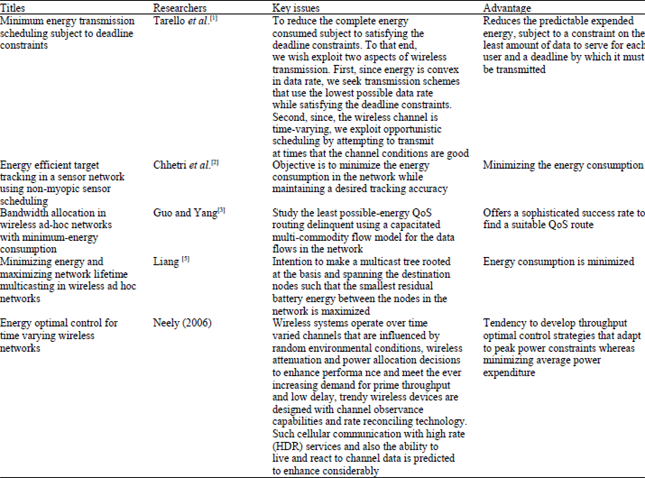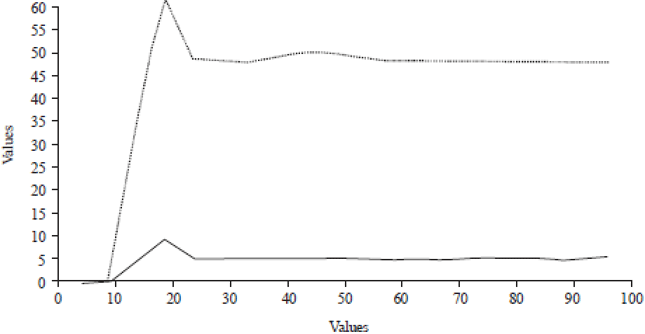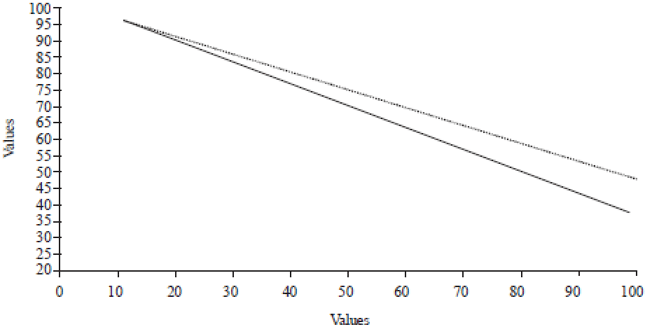Asian Journal of Information Technology
Balancing Energy Efficiency using Virtual Backbone Scheduling Algorithm in Wireless Sensor Networks
Authors : S. Nanthini, S. Nithya Kalyani and S. Sudhakar
Abstract: A WSN include a group of sensing element nodes which are joined to every other via. wireless communication. One of the inconsistent problems in WSN is energy constraint due to deficient battery as their energy. Adeptness of energy exhaustion and elongating network lifespan are challenge. The present review generosities the state of the inclination within the energy management schemes, the outstanding dares and also the open issues for future exploration work. In this study, we present virtual backbone scheduling algorithm for provide a better solution for the minimum energy scheduling problem in wireless sensor network.
How to cite this article:
S. Nanthini, S. Nithya Kalyani and S. Sudhakar, 2020. Balancing Energy Efficiency using Virtual Backbone Scheduling Algorithm in Wireless Sensor Networks. Asian Journal of Information Technology, 19: 45-49.
INTRODUCTION
The energy is the important parameter in wireless sensor network. The major drawback of any sensor node in WSN, if limited resource constraints. It is very essential to manage limited supply of battery present in sensor node. A sensor node is smaller in size and has sensing, processing and computing capabilities. All these operations consumes reasonable amount of energy. Each sensor node is energy and resource constrained node. Since, the battery enabled in sensors are not changeable, losing the energy will slowly make the sensor node to fail. The network lifetime depends on the resources used in WSNs. Energy optimization mechanisms are used to enhance the network lifetime. Due to insufficiency of energy provisions in wireless nodes, it is imperative to study the energy consumption of the scheduling algorithm which is the special interest in energy constrained wireless network such as wireless sensor networks. The wireless mobile hosts communicate in a multi-hop fashion. In sensor and robotics networks energy is the most important constraint and much research has forced on minimizing the power consumption.
Energy models and other related issues: Wireless network energy management is an in important issue. The enhancement in battery equipment is very slow compared to advances in semiconductor technology. Lack of central coordination, difficulty to replace the battery and limited energy source in battery motivates the researchers to design an efficient energy model. This section discusses the radio energy model and other power related issues.
Energy model: Energy conservation is the main target in energy constrained communication and focused has been given to minimize the transmission energy. In wireless networks the maximum number of bits a node can transmit depends upon the total battery energy. The energy depletion of radio interface depends upon the operation mode. These modes are active, sleep, idle and transient. Power consumption in active mode is maximum and least in sleep mode. In active mode more power are consumed for transmission or reception of packets and in sleep mode least power is consumed as transceiver has nothing to do during that period. Idle mode consumes more power than sleep mode as node has neither transmitting nor receiving any network packets but is waiting for it.
| Table 1: | Literature survey |
 |
|
Transition from one mode to other mode is called transient mode operation. Transition time is normally very less but if frequent transition occurred among the node then more power will be consumed.
Energy issue: Energy issues such as causes of energy waste and energy consumptions measuring are discussed here.
Causes of energy waste: The major cause of energy surplus in wireless networks is collision, idle listening, overhearing and control packet overhead. Collision results in retransmission leading to wastage of energy. Attending to an idle channel for possible traffic is known as idle listening. Power consumption in ideal state is very much close to active state. Most of the energy efficient mac protocol uses power management techniques to overcome this. Power save protocols put radio interface to sleep state to reduce idle state power consumption. When a node receives packets which is meant for other nodes is called the overhearing. Control packets are used for efficient data transmission. Excess use of control packets cost more in term of energy as well as utilization of limited bandwidth. Other cause to energy waste are higher bit rate, long header and carrier sensing. Header compression and packet splitting are used to reduce power consumption and efficient techniques are developed for carrier sensing. It is also found that low power transmission reduces contention and consumes less power. To design an efficient mac factors like delay, throughput, Quality of Service (QoS) and other factors must be considered along with energy consumption.
Energy consumption measuring: Before designing any energy-aware protocol for wireless network one have to know the energy consumption behaviour of the network interface. The energy consumed by an interface depends upon its operating state. Transmit and receive states are used for sending and receiving data. Sleep state consumes very less power than any other state. Due to this most of the power save protocol put their network interface in sleep state to save energy (Table 1).
PROBLEM ANALYSIS
Energy optimization is one of the major issues in the wireless network because most of the systems use battery power for their functionalities in the mobile environment. Most of the scheduling algorithm are designed to stabilize the network under arbitrary traffic load and achieve the throughput-optimalit but the energy optimize is in vain. So, it is necessary to optimize the use of energy in wireless network
EXISTING SYSTEM
Maxweight algorithm: Maxweight algorithm, a.k.a., back-pressure algorithm has established much consideration as a feasible solution for dynamic link scheduling in multi-hop wireless networks. The important belief of the maxweight algorithm is to decide on a group of interfering-free links that has maximum overall link weights within the network wherever the link weight is resolute by the queue difference between the transmitter and the receiver. While the throughput-optimality of the max weight algorithm is well implicit in the literature, the energy consumption induce by max weight algorithm is less studied which is of great concern in energy-embarrass wireless networks such as wireless sensor networks. Maxweight algorithm is known to be throughput optimal but not energy optimal because the vast energy consumption during packet retransmission is completely neglected by the max weight algorithm. While the throughput-optimality of the max weight algorithm is well understand, the energy consumption induce by the max weight algorithm is fewer deliberate in the literature.
PROPOSED SYSTEM
Virtual backbone scheduling is a more suitable approach to make energy management efficiently in WSNs. In this research, virtual backbone based minimum energy scheduling made among the wireless nodes. It makes available backbone scheduling which helps to manage the radio by dynamically turning it on and off in order to save energy.
It is a novel sleep-scheduling technique intended for WSNs has spare sensor nodes. It forms several overlapped backbones which work as a replacement for to prolong the network lifetime. The traffic is simply forwarded by backbone sensor nodes and the rest of the sensor nodes turn off their radios to save energy.
SIMULATIONS
Many network simulators are available like open net modular, glomosim, NS2, etc. but NS-2 network simulators is chosen for the proposed project. NS2 chosen because of supports networking research and education purpose. NS2 is suitable for designing of new protocol and comparison of traffic evolutions. NS2 open sources freely available in internet. Most of the people develop and they utilize for research. This NS2 is mostly runs on Linux and Mac operating systems. NS2 is object-oriented, discrete event driven network simulator which is developed at UC Berkley. And this program is completely written in C++ and TCL. NS2 is primarily useful at local area network. For the first time those who using this it is difficult but it is easy to use. To work with this simulation there is lot of documentation is available which is written by the developers.
Simulation model: Network Simulator (NS-2.33) accepts input as a scenario file. The proposed project runs under 2 mbps bit rate. And the fixed number of packet sizes of 512 bytes with a pause time. The simulation uses 8 different nodes with two source and destination. The scenario contains exact way of each node and the exact packets source by each node and with that exact time at which each change in motion or packet sources is to occur. The trace file created by each run, it the file stored in disk and it is analysed using a variety of scripts and the file is calls trace file with extension of (.tr). The trace tile that counts the number of packets successfully delivered and the length of the paths taken by the packets as well as additional information about the internal functioning of each script executed. This data is further analysed with AWK file. Figure 1 and 2 show the exact flow of data.
Throughput: Throughput refers to how much data can be transmitted from one location to another in a given amount of time (Fig. 3).
 | |
| Fig. 1: | Packet discovery |
 | |
| Fig. 2: | Packet dropping |
 | |
| Fig. 3: | Throughput |
 | |
| Fig. 4: | Energy consumption |
Energy consumption: This measures the energy expended per delivered data packet. Figure 4 which is generated in our work, it shows the energy consumption. The graph plotted time versus energy consumption.
CONCLUSION
The virtual backbone scheduling which is achieves longer life time over existing system. It improves energy efficiency of wireless sensor network.